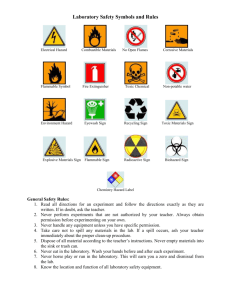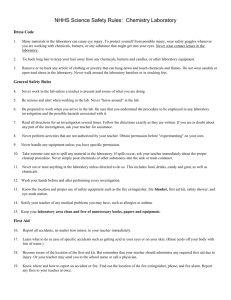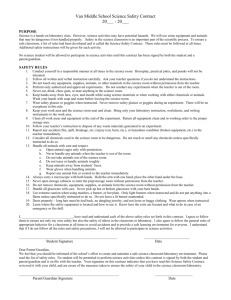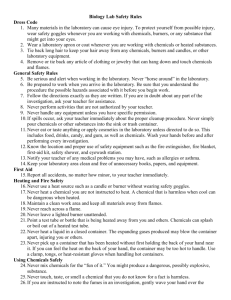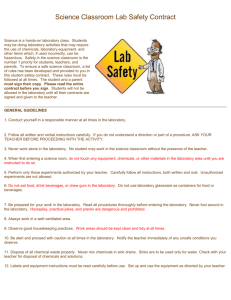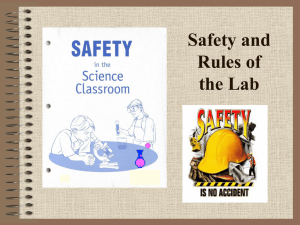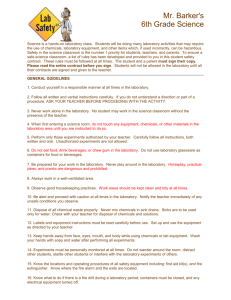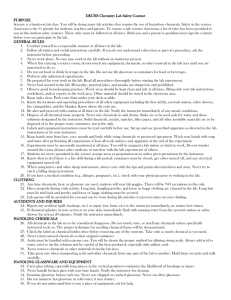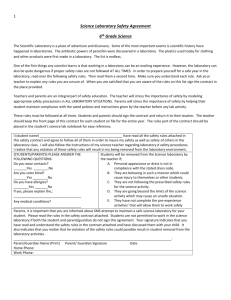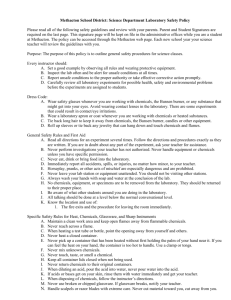Science Safety Rules
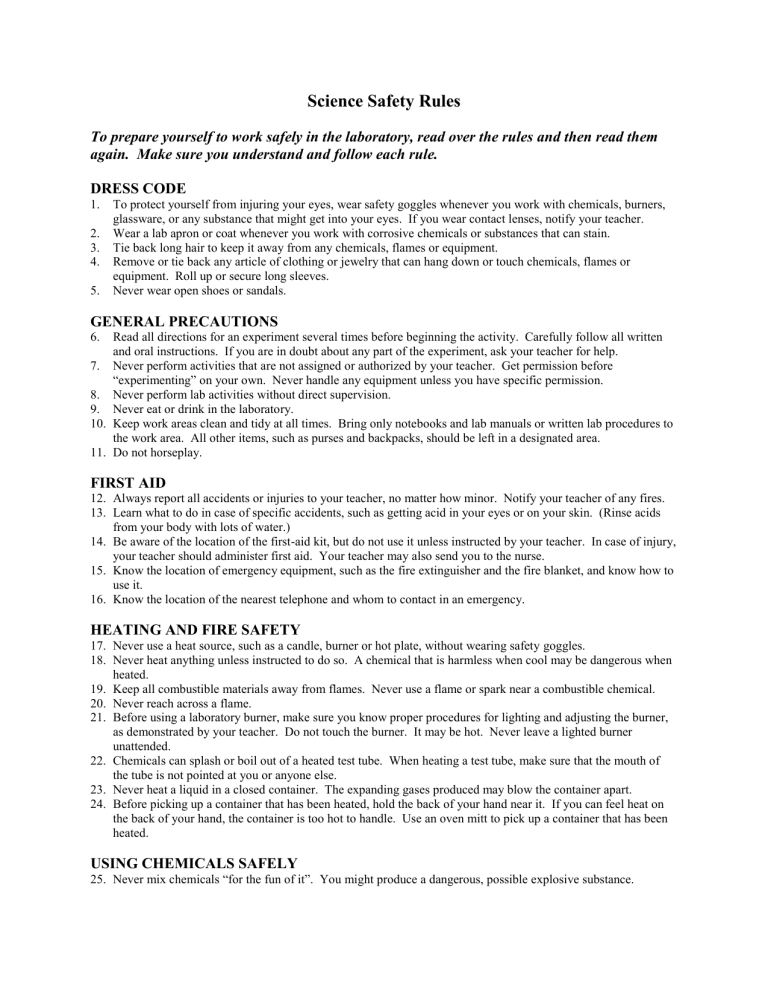
Science Safety Rules
To prepare yourself to work safely in the laboratory, read over the rules and then read them again. Make sure you understand and follow each rule.
DRESS CODE
1.
To protect yourself from injuring your eyes, wear safety goggles whenever you work with chemicals, burners, glassware, or any substance that might get into your eyes. If you wear contact lenses, notify your teacher.
2.
Wear a lab apron or coat whenever you work with corrosive chemicals or substances that can stain.
3.
Tie back long hair to keep it away from any chemicals, flames or equipment.
4.
Remove or tie back any article of clothing or jewelry that can hang down or touch chemicals, flames or equipment. Roll up or secure long sleeves.
5.
Never wear open shoes or sandals.
GENERAL PRECAUTIONS
6.
Read all directions for an experiment several times before beginning the activity. Carefully follow all written and oral instructions. If you are in doubt about any part of the experiment, ask your teacher for help.
7.
Never perform activities that are not assigned or authorized by your teacher. Get permission before
“experimenting” on your own. Never handle any equipment unless you have specific permission.
8.
Never perform lab activities without direct supervision.
9.
Never eat or drink in the laboratory.
10.
Keep work areas clean and tidy at all times. Bring only notebooks and lab manuals or written lab procedures to the work area. All other items, such as purses and backpacks, should be left in a designated area.
11.
Do not horseplay.
FIRST AID
12.
Always report all accidents or injuries to your teacher, no matter how minor. Notify your teacher of any fires.
13.
Learn what to do in case of specific accidents, such as getting acid in your eyes or on your skin. (Rinse acids from your body with lots of water.)
14.
Be aware of the location of the first-aid kit, but do not use it unless instructed by your teacher. In case of injury, your teacher should administer first aid. Your teacher may also send you to the nurse.
15.
Know the location of emergency equipment, such as the fire extinguisher and the fire blanket, and know how to use it.
16.
Know the location of the nearest telephone and whom to contact in an emergency.
HEATING AND FIRE SAFETY
17.
Never use a heat source, such as a candle, burner or hot plate, without wearing safety goggles.
18.
Never heat anything unless instructed to do so. A chemical that is harmless when cool may be dangerous when heated.
19.
Keep all combustible materials away from flames. Never use a flame or spark near a combustible chemical.
20.
Never reach across a flame.
21.
Before using a laboratory burner, make sure you know proper procedures for lighting and adjusting the burner, as demonstrated by your teacher. Do not touch the burner. It may be hot. Never leave a lighted burner unattended.
22.
Chemicals can splash or boil out of a heated test tube. When heating a test tube, make sure that the mouth of the tube is not pointed at you or anyone else.
23.
Never heat a liquid in a closed container. The expanding gases produced may blow the container apart.
24.
Before picking up a container that has been heated, hold the back of your hand near it. If you can feel heat on the back of your hand, the container is too hot to handle. Use an oven mitt to pick up a container that has been heated.
USING CHEMICALS SAFELY
25.
Never mix chemicals “for the fun of it”. You might produce a dangerous, possible explosive substance.
26.
Never put your face near the mouth of a container that holds chemicals. Never touch, taste or smell a chemical unless you are instructed by your teacher to do so. Many chemicals are poisonous.
27.
Use only those chemicals needed in an activity. Read and double-check labels on supply bottles before removing any chemicals. Take only as much as you need. Keep all containers closed when chemicals are not being used.
28.
Dispose of all chemicals as instructed by your teacher. To avoid contamination, never return chemicals to their original containers. Never simply pour chemicals or other substances into the sink or trash containers.
29.
Be extra careful when working with acids or bases. Pour all chemicals over the sink or a container, not over your work surface.
30.
If you are instructed to test for odors, use a wafting motion to direct the odors to your nose. Do not inhale the fumes directly from the container.
31.
When mixing an acid and water, always pour the water into the container first, and then add the acid to the water. Never pour water into an acid.
32.
Take extreme care not to spill any material in the laboratory. Wash chemical spills and splashes immediately with plenty of water. Immediately begin rinsing with water any acids that get on your skin or clothing and notify your teacher of any acid spill.
USING GLASSWARE SAFELY
33.
Never force glass tubing or thermometers into a rubber stopper or rubber tubing. Have your teacher insert the glass tubing or thermometer if required for an activity.
34.
If you are using a laboratory burner, use a wire screen to protect glassware from any flame. Never heat glassware that is not thoroughly dry on the outside.
35.
Keep in mind that hot glassware looks cool. Never pick up glassware without first checking to see if it is hot.
See rule 24.
36.
Never use broken or chipped glassware. If glassware breaks, notify your teacher and dispose of the glassware in the proper broken-glassware container.
37.
Never drink or eat from lab glassware.
38.
Thoroughly clean glassware before putting it away.
USING SHARP INSTRUMENTS
39.
Handle scalpels or other sharp instruments with extreme care. Never cut material toward you; cut away from you.
40.
Immediately notify your teacher if you cut your skin when working in the laboratory.
ANIMAL AND PLANT SAFETY
41.
Never perform experiments that cause pain, discomfort or harm to mammals, birds, fishes or amphibians. This rule applies at home as well as in the classroom
42.
Animals should be handled only if absolutely necessary. Your teacher will instruct you as to how to handle each animal species brought into the classroom.
43.
If you know that you are allergic to certain plants, molds or animals, tell your teacher before doing any activity in which these are used.
44.
During fieldwork, protect your skin by wearing long pants, long sleeves, socks and closed shoes. Know how to recognize the poisonous plants and fungi in your area, as well as plants with thorns and avoid contact with them.
45.
Never eat any part of an unidentified plant or fungus.
46.
Wash your hands thoroughly after handling animals or the cage containing animals. Wash your hands when you are finished with any activity involving animal parts, plants or soil.
END-OF-EXPERIMENT RULES
47.
After an experiment has been completed, clean up your work area and return all equipment to its proper place.
48.
Dispose of waste materials as instructed by your teacher.
49.
Wash your hands after every experiment.
50.
Always turn off all burners or hot plates when they are not in use. Unplug hot plates and other electrical equipment. If you used a burner, check that the gas-line valve to the burner is off as well.
